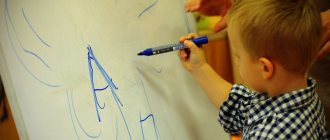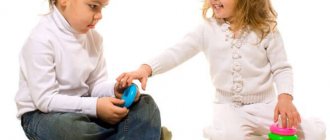With the greatest interest in the second half of life, children find out the relationships of objects with each other: how large toys relate to small ones and how small objects can be placed in large ones.
Improving the skills of hands and fingers allows the child to invent various combination games with toys - knocking one on the other, piling toys into a pile and (the most favorite activity) filling and emptying certain containers. The ability to manipulate two toys at the same time opens up almost endless play possibilities for the baby.
Give your child a large plastic bucket or shoebox and watch as she tries to fill the containers with whatever comes her way. Now watch how the baby combines the cube and the container. His mind and hands work together, figuring out how to put the cube in the box and, of course, how to take it out. After playing “put it in and take it out,” he will begin to shake the cube in the container, getting great pleasure from the sound that is heard. Look how attentive and concentrated the expression on the child’s face became when he was busy with these game combinations.
Photo by Kevin Gent on Unsplash
Bring pots and pans from the kitchen (we recommend filling your ears with cotton wool first!). The baby will be delighted with the opportunity to put a small saucepan in a large one and, of course, rattle them. Playing with the faucet and sink in the bathroom (only under your supervision!) provides an opportunity to practice pouring and pouring. Scooping up water with a cup and then pouring it out is one of the favorite pastimes of kids.
Place your baby in a large laundry basket, half-filling it with socks and assorted baby clothes. He will empty it for a long time and with great pleasure, throwing away one thing after another. When all the laundry is on the floor, take the smallest “helper” out of the basket and show him how to “fold” everything back. Pick up the sock and defiantly put it in the basket. The “helper”, with the same gusto as he unloaded, will begin to fill the basket again.
To make it more convenient to take
Place an unsharpened pencil on the table and see how your baby picks it up. Now turn the pencil at a different angle and notice how the baby changes the position of his hand - he will tilt it at the same angle at which the pencil lies, and he will do this during the movement itself. Just recently, a child impulsively grabbed an object with his whole hand, without trying out how to do it more conveniently. Now, while his hand is reaching for some object, he is wondering how best to take it.
How to make a child laugh

Nowadays, there are a huge variety of ways to make a baby laugh. But mothers and fathers should understand that not all methods are suitable for their baby. Because the character and habits of a small child are individual.
So, for example, when playing one of the most common games “Peek-a-boo” with parents, one baby will start laughing loudly, and the other will start crying. That is why new parents should choose those methods that are suitable specifically for their baby, based on the characteristics of his behavior.
Massage and gymnastics for a child 4–6 months (Complex 3)
By 4–6 months, the child becomes more active, he is keenly interested in his surroundings and unfamiliar objects. Try to satisfy his curiosity: walk around the house with him so that the baby can observe the life of adults and communicate with them. However, he should also have a “private life”: independent activities with toys that need to be hung above the crib so that the child can reach them. You can periodically place a rattle in his hand, but the best toys for a baby of this age are his own legs and arms, which he examines for a long time or puts in his mouth. By 4–5 months, the increased tone of the flexors completely disappears, and the movements of the child’s arms and legs become more free and purposeful. If this does not happen, the baby’s motor development is delayed. After 5 months of age, this may indicate some disease, a disorder in the development of the central or peripheral nervous system, malnutrition, as well as improper and inattentive care. The normal development of a child is an involuntary phenomenon; it occurs under the influence of a set of consciously created external conditions, therefore the opinion that the baby develops without adult intervention is fundamentally wrong. Even a child with very good natural inclinations, but deprived of daily baths, massage, gymnastics and communication with adults, will very soon begin to lag behind in development, not only physically, but also mentally. At 4–5 months of age, the child can already independently roll over from his back to his stomach, and from a lying position on his stomach he can rise with outstretched arms. If you take the baby under the arms and “put” him on a support, he “stands” straight, without trying to bend his legs. In addition, at this age, the child, clinging to the bars of the crib with his hands, tries to sit up. However, there is no need to rush to sit him down: his spine is not yet ready for such loads and early sitting can lead to serious posture problems. If the child has a special chair or backpack, you need to provide his back with strong support. And if you really want him to develop faster, it’s better to stimulate his desire to crawl. During the first months of life, the baby learns to use its arms and legs to propel itself forward. At the same time, he crawls with his stomach on the floor or changing table. At the very beginning, the child’s movements are erratic, he can rearrange his legs and arms at random. Later, he extends his arms forward while simultaneously pushing off the floor with his legs. Then he begins to lean his whole body on his hands, and begins to “rake” with his legs. This type of movement is called homological: this is how frogs move in nature. The baby can also move in the following way: stretch his right arm and right leg forward and at the same time push off with the opposite arm and leg. Then the child extends his left arm and left leg and pushes off with his right limbs. Such movements are called homolateral. A healthy child quickly passes through these stages of movement and moves on to the next one, called crossover. In this type of movement, the most typical for a person, the child moves forward by pushing the body forward with the left leg and right arm, while simultaneously pulling up the right leg and left arm in order to transfer the fulcrum to them and prepare for the next motor act. It will be more interesting for a child to crawl if his toys are laid out so that he can see them clearly, but cannot reach them with his hand. In this case, you need to increase the distance from time to time, taking into account your progress in crawling. When the baby reaches the goal again, praise him and let him play with the “prey”. But most of all, children like to crawl after their mother. A small child has two cherished desires: to be close to you and to explore the world around him, using a new way of moving. A baby who cannot walk because he is unable to hold his body upright lives in a horizontal world. Try to go to his level for a while, play with him on the floor. Of course, the playing environment should be as safe as possible, and the floor should be clean, level and warm. But the main thing is your attitude towards crawling, because the baby’s reaction to this activity will be an exact copy of your emotions. So, if you are used to treating the floor as a strange and even hostile place for your baby, he will also copy your emotions. In addition, if the child understands that being on the floor makes him alone, he will associate the floor with discomfort and isolation. For a small child, a mother is love, warmth, nutrition, protection, happiness and a source of new information, so if your baby is on the floor, you should be nearby. Daily gymnastics and massage now last a little longer - up to 30 minutes. It is very important that during classes the baby maintains a joyful and cheerful mood and performs new, more complex movements with pleasure. In this regard, it is advisable to accompany exercises such as boxing, crossing arms, straightening and bending legs with rhythmic counting. You can also conduct classes to rhythmic but quiet music. The main goals of classes with a 4-6 month old child are: – final normalization of leg muscle tone; – education of the support reaction of the feet; – teaching the baby to hold objects; – development of rhythmic movements. To do this, you need to use: – rhythmic counting and affectionate communication during classes; – active reflex exercises based on the child’s desire to sit down; – passive exercises; – age-appropriate toys; – swimming; – massage using more intense techniques. Massage techniques intended for this age become more complicated, and the procedure itself becomes longer. In addition to stroking and rubbing, kneading is introduced - its most “gentle” variants: longitudinal kneading and felting. The last technique should be performed with the palms facing each other: the massaged muscle is placed between them. Longitudinal kneading is done with one hand, while the other should support the child’s limb. Massage movements should be rhythmic, soft and performed at an average pace. Try to avoid pinching the skin between your fingers and sudden jerks. To increase the tone of muscle tissue, stimulating techniques are used - pinching and effleurage, which must be performed easily, rhythmically and quickly. But do not forget that any massage should begin and end with stroking, which can be performed among other massage techniques.
Complex 3
1. Hand massage: – stroking (3-4 times); – ring rubbing (3-4 times); – stroking (2-3 times). 2. Crossing arms (6–8 times). 3. Foot massage: – stroking (2-3 times); – ring rubbing (3-4 times); – longitudinal kneading or felting (2-3 times); – stroking (2-3 times). 4. “Sliding steps” (5-6 times). 5. Extension and bending of the legs (5–6 times). 6. Turn on your stomach (2-3 times in each direction). 7. Massage of the buttocks and back: – stroking over the entire surface (2-3 times); – rubbing or sawing over the entire surface (2–3 times); – stroking over the entire surface (2–3 times); – kneading the long back muscles (5–6 times); – kneading the muscles of the buttocks (5-6 times); – pinching or tapping the gluteal muscles; – stroking (2–3 times). 8. “Hovering” on the stomach (1 time for a few seconds). 9. Abdominal massage: – stroking (counter, circular and oblique abdominal muscles – 2-3 times); – rubbing with fingertips over the entire surface (2-3 times); – sawing the rectus abdominis muscles (2–3 times); – pinching of the umbilical area; – all stroking techniques (2-3 times). 10. Squat with spine bending (1 time). 11. Reflex exercises and foot massage: – stroking (2-3 times); – rubbing (5-6 times); – effleurage; – stroking (2-3 times); – extension and flexion of the feet (5-6 times). 12. Dancing. 13. Breast massage: – stroking (2-3 times); – vibration massage (3–4 times); – stroking (2–3 times). 14. “Hovering” on your back. 15. Circular movements with your arms or “boxing” exercise (5-6 times). 16. Crawling. 1. Hand massage, stroke the entire hand 3-4 times, then 3-4 circular rubbings and stroking again (see complex 2, exercise 1). If muscle tone is balanced after 4 months, and the child’s palm opens well, hand massage can no longer be done. 2. Crossing arms on the chest The description of this exercise is given in complex 2, exercise 2. At the age of 3–6 months, the child should be able to hold onto your fingers well, so it is not necessary to hold his hand during the exercise. The tempo of movements can be changed from slow to fast, then back to slow. Accompany the exercise with rhythmic counting. 3. Leg massage Perform stroking along the entire length of the leg, then proceed to circular rubbing along the outer surface of the legs (see complex 2, exercise 3). A new technique is kneading (longitudinal kneading and felting). Perform felting as follows: place the child’s shin between your palms so that one hand is on the back of the shin and the other on the outer surface. With both palms, simultaneously make circular, energetic movements directed in opposite directions, working the muscles. Gradually move towards the thigh, then back. This technique must be performed 2-3 times (Fig. 27). When kneading longitudinally, you need to place the child’s leg on your palm, supporting it by the lower part of the shin. With your other hand, grab the muscles of the outer part of the shin and, moving them towards the big toe, perform simultaneously circular and translational movements, as when kneading dough (Fig. 28). After stretching the muscles of the outer part of the leg and thigh, return back to the foot. This technique must be performed 2-3 times in both directions. Finish the massage by generally stroking the baby's feet. Rice. 27. Felting Fig. 28. Longitudinal kneading 4. “Sliding steps” This exercise is described in complex 2, exercise 4. By 4–6 months, the baby’s leg movements are almost free, since the muscle tone is already well balanced. Do the “steps” at first at a slow pace, then speed up, and at the end of the exercise slow down the movements. The exercise is best performed with a rhythmic count. 5. Extension and flexion of legs Starting position: the child lies on his back with his feet facing you. Grab them by the top of your shins so that your thumbs are on the inside of your shins and your thumbs are on the outside and back of your shins. Bend both of your baby's legs at the same time, spreading your knees and applying gentle pressure to your belly. After this, slowly straighten them. Repeat the exercise 5-6 times with a rhythmic count. If the baby resists bending his legs, you should first lightly stroke the area under the knees, then the movement will be easier. If, on the contrary, the child does not want to straighten his legs, the movement should be performed with slight shaking, then straightening his legs will be easier. 6. Turning onto his stomach At 5 months of age, the baby can already roll over onto his stomach on his own and does not require hand support, so place a bright toy on the side in which he should turn and ask him to do this, saying: “Turn over on his stomach.” ! The words should be supported by a slight rotation of the baby’s pelvis and legs in the desired direction (Fig. 29). Rice. 29. Turn on the stomach 7. Massage of the buttocks and back Start the massage with 2-3 strokes over the entire surface of the back and buttocks. Then rub with the back of your slightly bent fingers or with their pads (see complex 2, exercise 6). You can add sawing to the already familiar techniques. It must be performed with the edge of one or both palms. If both hands are involved, place them 1–2 cm apart. Make movements in opposite directions, gradually moving along the entire back (Fig. 30). Kneading is carried out in the form of rolling or sliding. The essence of these movements is the displacement of soft tissues and their semicircular compression (Fig. 31). Between rubbing, sawing and kneading, be sure to stroke. Rice. 30. Sawing on the back Fig. 31. Kneading the back muscles When the baby's back turns pink, you can move on to rubbing the buttocks. Then they need to be kneaded well (Fig. 32). Tap the buttocks with the back of your bent fingers (Fig. 33). Rice. 32. Kneading the buttocks Fig. 33. Tapping the buttocks Movements should be rhythmic, light and fast. However, this technique cannot be performed in the lumbar region (projection area of the kidneys). Effleurage can be replaced by pinching (Fig. 34) or chopping (Fig. 35), and the massage should be completed with stroking. Rice. 34. Pinching the buttocks Fig. 35. Chopping the buttocks 8. “Hovering” on the stomach Starting position: the child lies on his stomach with his feet facing you. Place your palms under his belly so that your little fingers touch and your thumbs are level with his lower ribs. Holding your baby under his stomach, lift him off the table so that he is in a horizontal position. In this case, the child’s legs should rest on your chest, and his body should form an arc. The muscles of the buttocks and back are tense, the head is raised (Fig. 36). This exercise is based on innate position reflexes and is an excellent workout for the vestibular system and the posterior muscles of the entire body. Rice. 36. “Soaring” on the stomach 9. Abdominal massage First, perform stroking: circular, counter and oblique abdominal muscles. After this, rub your stomach with your fingertips (see complex 2, exercise 9): first, circular rubbing, then rubbing the rectus abdominis muscles. After this, you can add pinching around the navel to prevent umbilical hernia and strengthen the tissues of the umbilical ring (Fig. 37). At the end of the belly massage, do not forget to stroke, while trying not to press too hard on the baby’s belly. Rice. 37. Pinching around the navel 10. Squat with spine bending Starting position: the child lies on his back with his feet facing you. Place your thumbs in his palms and wrap your fingers around his hands. Then spread your baby's arms to the sides and straighten them. After this, lightly pull the child by the arms with the words “Sit down” or “Let’s sit down,” encouraging him to raise his upper body and head and gradually bringing his body position to a sitting position (Fig. 38). Place your child's hands in one hand, bringing them together in front and at the top. In this position, use the middle and index fingers of your free hand to run along the baby’s back from bottom to top along the spine. At the same time, he must straighten it (Fig. 39). This exercise should be performed 1-2 times, and then carefully lower the child onto the table, supporting his head with your hand. This active exercise is based on the baby's desire to sit down and the innate skin-dorsal reflex. At the beginning of the exercise, the abdominal muscles and the front of the neck are involved, and at the end - the back muscles. In addition, this is very good preparation for future independent sitting. Rice. 38. Squat Fig. 39. Squat with spine bending 11. Reflex exercises and foot massage Stroking and rubbing the child’s feet (see complex 2, exercises 11 and 12). Then, by pressing on the base of the toes and rubbing the outer edge of the foot, cause reflex extension and flexion of the baby’s feet. Complete the massage with light tapping and stroking on his soles. 12. Dancing Starting position: take the child under the arms and “put” his back or face to you. This exercise is a variation of reflex “walking”. The fact is that the step reflex, as a rule, fades away by the age of 4 months, but when the feet rest on a hard surface, the child begins to “dance” in place. While performing this exercise, make sure that the baby does not stand on tiptoes: this way you will develop a good support reaction in him. 13. Breast massage Stroking the upper half of the chest 2-3 times. After this, perform a vibration massage of the entire chest (see complex 2, exercise 14). Then stroke the baby along the intercostal spaces 2-3 times. 14. “Hovering” on the back Starting position: the child lies on his back with his feet facing you. Place your hands under the child's back and clasp his body so that your hands are at the level of the lower ribs and clasp his body by the back and sides of the chest. Lift your baby horizontally. In response to this, the child should tilt his head forward and tense the muscles of the front of the body (Fig. 40). Rice. 40. “Hovering” on the back If the baby persistently throws his head back, the exercise should not be performed: the child is not yet ready for it. To begin with, hold the child in a semi-upright position, each time decreasing the angle of inclination. 15. Circular movements of the arms or the “boxing” exercise An exercise for the arms, reminiscent of boxer’s blows (see complex 2, exercise 15), can now be complicated by placing rings or rattles in the child’s hands. Perform all movements, changing the tempo and counting rhythmically. When moving your arms in a circular motion, the starting position is: the child lies on his back with his feet facing you. Place your thumbs in your baby's hands, then slowly and smoothly spread his arms to the sides, then lift them to his head, then lower them down and forward. Repeat the exercise 4–6 times, counting rhythmically. Then you need to move your arms in the opposite direction: first forward, then up to the head and finally down and to the sides. These movements must be repeated at a slow pace 4-6 times. Circular movement of the arms is a passive exercise that is quite difficult for the muscles of the shoulder girdle and arms. In fact, this is a passive combination of all possible movements of the shoulder joint, so this exercise can be performed only after the baby has mastered crossing the arms and the “boxing” exercise well. 16. Crawling Starting position: the child lies on his back with his feet facing you. Grasp the lower parts of the shins, then bend and straighten them, performing movements similar to those of a frog. After a few passive movements, hold your child's legs in the hips apart position and allow him to push off on his own. As a result of the push, the baby should move forward. After this, you need to bend his legs again, stimulating the next movement. As an additional incentive, you can use a toy by placing it at some distance from the child to make crawling more interesting for him.











